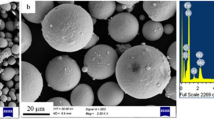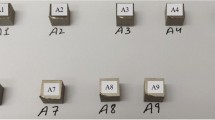Abstract
The surface roughness of laser powder bed fusion (L-PBF) parts is one of the most important criteria governing their quality and fitness for use. The surface quality of L-PBF components is traditionally improved through mechanical polishing. However, in recent years, laser polishing (LP), in which laser radiation is used to melt a thin layer of metal on the component surface, has attracted increasing attention. Accordingly, a simulation model is considered the potential approach to explore insights into the process and to optimize the LP processing conditions. Previous studies which focus on building simulation for the LP process neglected the effect of the initial surface profile on the absorption of laser energy as laser irradiates the surface. In an effort to address this issue and to create a foundation for optimizing the processing conditions in LP, in this work, a new computational framework is proposed for predicting the surface profile of L-PBF parts following the LP process. For taking into account the effect of initial L-PBF processed roughness on the laser absorption, the proposed approach commences by using a mathematical model to reconstruct the measured surface profile of the printed part. Ray-tracing simulations are then performed to investigate the interaction between the laser radiation and the surface profile and to evaluate the absorption of the metal surface. Finally, heat transfer simulations, fast Fourier transform analyses, and a low-pass filter algorithm are employed to simulate the final surface profile of the L-PBF component following laser polishing. It is found that the predicted values of mean roughness (Ra) and root mean square (Rq) differ from experiment by no more than 7.7% and 9.8%, respectively. Additionally, the simulated correlation length (cl) which is the parameter illustrating the variation of height in the lateral direction is also compared with one attained from experiment. It is observed that the maximum error between simulated correlation length and one attained from the experiment is no more than 13.4%.
















Similar content being viewed by others
Data availability
The authors assure the transparency and availability of data and material, and adhere to discipline-specific rules for acquiring, selecting and processing data.
Code availability
The authors make sure we have permissions for the use of software and the availability of the custom code.
References
Chen H, Yan W (2020) Spattering and denudation in laser powder bed fusion process: Multiphase flow modelling. Acta Mater 196:154–167
Snow Z, Nassar AR, Reutzel EW (2020) Invited review article: review of the formation and impact of flaws in powder bed fusion additive manufacturing. Addit Manuf 36:101457
Mirkoohi E, Tran H-C, Lo Y-L, Chang Y-C, Lin H-Y, Liang SY (2020) Analytical mechanics modeling of residual stress in laser powder bed considering flow hardening and softening. Int J Adv Manuf Technol 107(9):4159–4172
Tucho WM, Lysne VH, Austbø H, Sjolyst-Kverneland A, Hansen V (2018) Investigation of effects of process parameters on microstructure and hardness of SLM manufactured SS316L. J Alloy Compd 740:910–925
Policena MR, Devitte C, Fronza G, Garcia RF, Souza AJ (2018) Surface roughness analysis in finishing end-milling of duplex stainless steel UNS S32205. Int J Adv Manuf Technol 98:1617–1625
Deng T, Li J, Zheng Z (2020) Fundamental aspects and recent developments in metal surface polishing with energy beam irradiation. Int J Mach Tools Manuf 148:103472
Annamaria G, Massimiliano B, Francesco V (2022) Laser polishing: a review of a constantly growing technology in the surface finishing of components made by additive manufacturing. Int J Adv Manuf Technol 1–40
Mohammad AEK, Wang D (2016) Electrochemical mechanical polishing technology: recent developments and future research and industrial needs. Int J Adv Manuf Technol 86:1909–1924
Lamikiz A, Sanchez J, de Lacalle LL, Arana J (2007) Laser polishing of parts built up by selective laser sintering. Int J Mach Tools Manuf 47:2040–2050
Yasa E, Kruth J-P (2011) Microstructural investigation of selective laser melting 316L stainless steel parts exposed to laser re-melting. Procedia Engineering 19:389–395
Yu W, Sing SL, Chua CK, Tian X (2019) Influence of re-melting on surface roughness and porosity of AlSi10Mg parts fabricated by selective laser melting. J Alloy Compd 792:574–581
Chen L, Richter B, Zhang X, Ren X, Pfefferkorn FE (2020) Modification of surface characteristics and electrochemical corrosion behavior of laser powder bed fused stainless-steel 316L after laser polishing. Addit Manuf 32:101013
Metelkova J, Vanmunster L, Haitjema H, Ordnung D, Kruth J-P, Van Hooreweder B (2021) Hybrid dual laser processing for improved quality of inclined up-facing surfaces in laser powder bed fusion of metals. J Mater Process Technol 117263
Panov D, Oreshkin O, Voloskov B, Petrovskiy V, Shishkovsky I (2022) Pore healing effect of laser polishing and its influence on fatigue properties of 316L stainless steel parts fabricated by laser powder bed fusion. Opt Laser Technol 156:108535
Richter B, Blanke N, Werner C, Vollertsen F, Pfefferkorn F (2019) Effect of initial surface features on laser polishing of Co-Cr-Mo alloy made by powder-bed fusion. JOM 71:912–919
Backes G, Gasser A, Kreutz E-W, Ollier B, Pirch N, Rozsnoki M, et al., (1990) Surface melting of AlSi10Mg with CO2 laser radiation. In: CO2 Lasers and Applications II, 402–410
Shao T, Hua M, Tam H, Cheung EH (2005) An approach to modelling of laser polishing of metals. Surf Coat Technol 197:77–84
Li K, Zhou H, Zhao Z, Zhou H, Yin J, Jin J (2021) A study on transient molten pool dynamics in laser polishing of Ti6Al4V using numerical simulation. J Manuf Process 65:478–490
Zhou J, Han X, Li H, Liu S, Yi J (2021) Investigation of layer-by-layer laser remelting to improve surface quality, microstructure, and mechanical properties of laser powder bed fused AlSi10Mg alloy. Mater Des 210:110092
Bergström D, Powell J, Kaplan A (2007) A ray-tracing analysis of the absorption of light by smooth and rough metal surfaces. J Appl Phys 101:113504
Bergström D, Kaplan A, Powell J (2005) Laser absorption measurements in opaque solids. In: Absorption of Laser Light by Rough Metal Surfaces, 49
Tran H-C, Lo Y-L (2019) Systematic approach for determining optimal processing parameters to produce parts with high density in selective laser melting process. Int J Adv Manuf Technol 105:4443–4460
TongTai Additive Manufacturing (2018) http://www.tongtai.com.tw/en/techpage.php?id=5&tag=3, http://www.tongtai.com.tw/en/techpage.php?id=5&tag=3. Accessed 24 April 2018
Hann D, Iammi J, Folkes J (2011) A simple methodology for predicting laser-weld properties from material and laser parameters. J Phys D Appl Phys 44:445401
Nečas D, Klapetek P (2012) Gwyddion: an open-source software for SPM data analysis. Open Physics 10:181–188
Strano G, Hao L, Everson RM, Evans KE (2013) Surface roughness analysis, modelling and prediction in selective laser melting. J Mater Process Technol 213:589–597
Bergström D (2008) The absorption of laser light by rough metal surfaces. Luleå tekniska universitet
Wang H, Kawahito Y, Yoshida R, Nakashima Y, Shiokawa K (2018) A model to calculate the laser absorption property of actual surface. Int J Heat Mass Transf 118:562–569
Dausinger F, Shen J (1993) Energy coupling efficiency in laser surface treatment. ISIJ Int 33:925–933
Tran H-C, Lo Y-L (2018) Heat transfer simulations of selective laser melting process based on volumetric heat source with powder size consideration. J Mater Process Technol 255:411–425
C. Multiphysics and C. M. H. T. Module (2014) COMSOL multiphysics user’s guide. Version: COMSOL Multiphysics, vol. 3
Loh L-E, Chua C-K, Yeong W-Y, Song J, Mapar M, Sing S-L et al (2015) Numerical investigation and an effective modelling on the selective laser melting (SLM) process with aluminium alloy 6061. Int J Heat Mass Transf 80:288–300
Trejos JD, Reyes LA, Garza C, Lopez O, Zambrano P (2020) Numerical modeling of thermal anisotropy on a selective laser melting process. Rapid Prototyp J
Mills KC (2002) Recommended values of thermophysical properties for selected commercial alloys. Woodhead Publishing, Cambridge
Le T-N, Lo Y-L (2019) Effects of sulfur concentration and Marangoni convection on melt-pool formation in transition mode of selective laser melting process. Mater Des 179:107866
Vadali M, Ma C, Duffie NA, Li X, Pfefferkorn FE (2012) Pulsed laser micro polishing: surface prediction model. J Manuf Process 14:307–315
Ukar E, Lamikiz A, Martínez S, Tabernero I, De Lacalle LL (2012) Roughness prediction on laser polished surfaces. J Mater Process Technol 212:1305–1313
Tran H-C, Lo Y-L, Huang M-H (2017) Analysis of scattering and absorption characteristics of metal powder layer for selective laser sintering. IEEE/ASME Trans Mechatron 22:1807–1817
Boley C, Khairallah S, Rubenchik A (2015) Calculation of laser absorption by metal powders in additive manufacturing. Appl Opt 54:2477–2482
Fotovvati B, Chou K (2022) Multi-layer thermo-fluid modeling of powder bed fusion (PBF) process. J Manuf Process 83:203–211
Funding
The authors gratefully acknowledge the financial support provided to this study by the National Science and Technology Council of Taiwan Under Grant No. MOST 110-2222-E-218-002-MY2 and MOST 110-2622-E-218-005. The study was also supported in part by the funding provided to the Intelligent Manufacturing Research Center (iMRC) at National Cheng Kung University (NCKU) by the Ministry of Education, Taiwan, Headquarters of University Advancement. The additional financial support received under the Higher Education Sprout Project of the Ministry of Education at Southern Taiwan University of Science and Technology is also greatly appreciated.
Author information
Authors and Affiliations
Contributions
All authors contributed to the study conception and design. Simulation data and the first draft of the manuscript were prepared by Dr. Hong-Chuong Tran. Experimental data collection was performed by Mr. Dac-Phuc Pham. All authors read and approved the final manuscript.
Corresponding author
Ethics declarations
Ethics approval
The authors declare that the submitted work is original. Neither the entire paper nor any part of its content has been published or has been accepted elsewhere. It is not being submitted to any other journal.
Consent to participate
The authors confirm that this research does not involve Human Participants and/or Animals.
Consent for publication
The authors consent for publication in The International Journal of Advanced Manufacturing Technology exclusively.
Conflict of interest
The authors declare no competing interests.
Additional information
Publisher's note
Springer Nature remains neutral with regard to jurisdictional claims in published maps and institutional affiliations.
Rights and permissions
Springer Nature or its licensor (e.g. a society or other partner) holds exclusive rights to this article under a publishing agreement with the author(s) or other rightsholder(s); author self-archiving of the accepted manuscript version of this article is solely governed by the terms of such publishing agreement and applicable law.
About this article
Cite this article
Tran, HC., Pham, DP. Integrated computational framework for predicting surface profile of laser powder bed fusion stainless steel SUS420 parts after laser polishing. Int J Adv Manuf Technol 123, 3613–3631 (2022). https://doi.org/10.1007/s00170-022-10373-2
Received:
Accepted:
Published:
Issue Date:
DOI: https://doi.org/10.1007/s00170-022-10373-2




